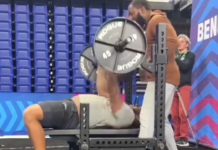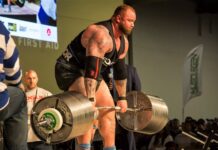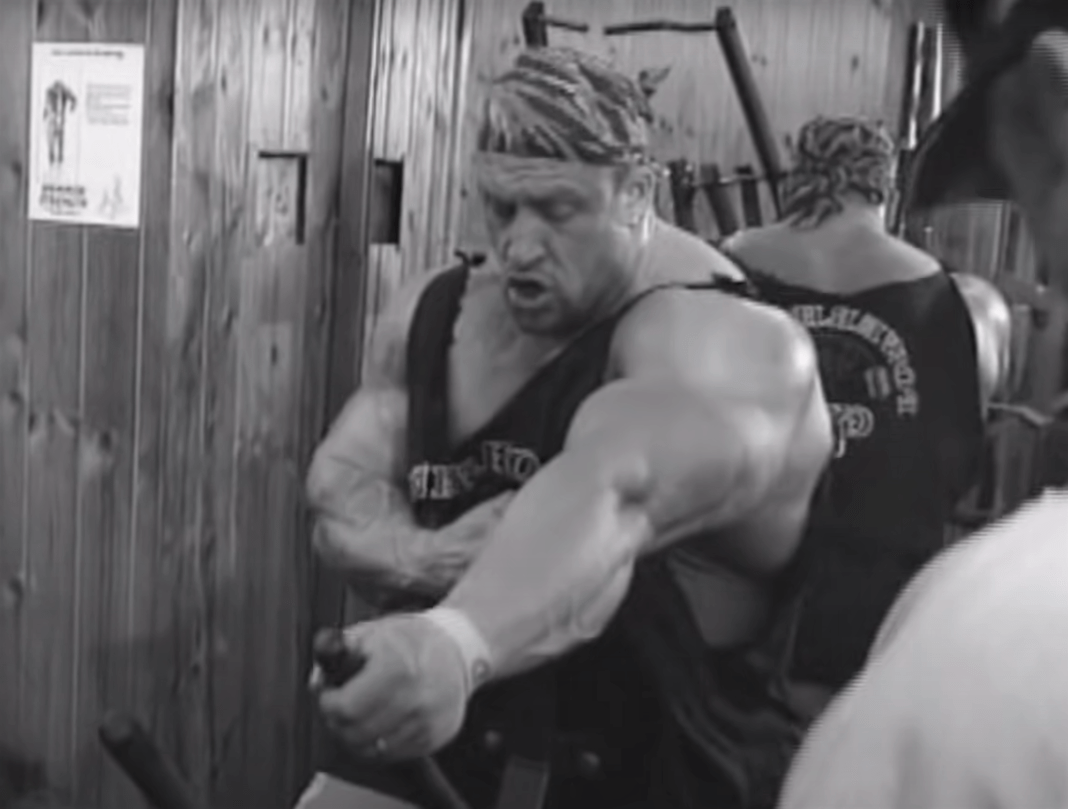YouTube / “Blood and Guts” screen capture / Kevin Horton
Dorian Yates resurrected high-intensity training and carried it on his enormous, granite back to new heights. Without Yates, HIT may have ended up just another dusty relic of the ’70s, like mood rings or bean bag chairs. It took a one-man “British Invasion” to once again make HIT relevant. During Dorian Yates’ six-year run (1992-97) atop the bodybuilding world as Mr. Olympia, high-intensity reached a new-level of acclaim and influence. Let’s examine how Yates utilized high-intensity techniques and analyze his full body workout from his Olympia-winning years to see exactly how he built a physique that revolutionized bodybuilding.
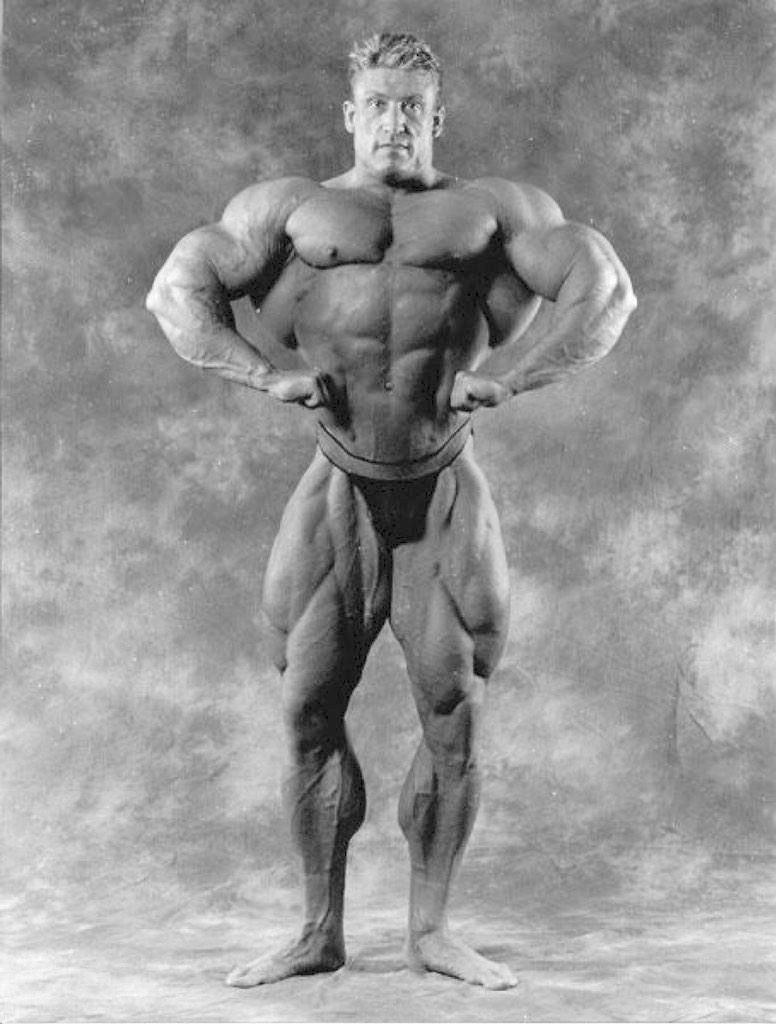
DORIAN YATES: THE HIT MAN
Before 21-year-old Dorian Yates picked up weights in 1983, he picked up books, reading all he could about training science. It was Mike Mentzer’s Heavy Duty that won over the Englishman. Then when he toiled in the dungeon-like Temple Gym in Birmingham, England, Yates modified Heavy Duty via experimentation. He did four to eight working sets per body part. He also put a Mentzer-like emphasis on low reps, doing around eight for most body parts. As he advanced, he pushed these sets beyond failure usually with 2-3 forced reps, but he also incorporated drop sets, rest-pause, and negatives. In 1988, Yates won the British Championships weighing 226—46 pounds heavier than he was five years prior. And he was about to launch the most consistently superb pro career of all time: 15 wins, 2 losses (both seconds).
By the time Dorian Yates hoisted his first of six consecutive Sandow trophies in 1992, he had settled on a training style of typically just one all-out working set per exercise. However, before this apex set, he usually pyramided warmup sets. And he sometimes did as many as three such warmups, going increasingly heavier. This led to a common misconception about his workouts. Some people observed Yates battling weights in person or on video and declared—aha!—he actually does a normal quantity of volume. Pfft. In fact, the confusion merely highlighted the difference between his working sets and those of most bodybuilders. Pyramided sets at moderate intensity were his warmups—mere preparation for the final (beyond failure) set of an exercise. To him, that working set was the only set that truly mattered.
Related content: Hit Training: Ultimate Guide to High-Intensity Workouts
As with Arthur Jones and his protégé Casey Viator in 1971-73 and Mike Mentzer in 1979-80, Yates inspired a new generation of bodybuilders in the ’90s to give HIT a chance. Once again, few stayed with the strict, low-volume dogma for long. But this time high-intensity training had lasting effects. Several neo-HIT philosophies developed, including Doggcrapp and Max-OT. And a lower training frequency became the norm. Pre-Yates, hitting body parts once every seven days was nearly unheard of. Today, it’s the most popular split among bodybuilders. Most importantly, because of Dorian Yates’ influence then and continuing influence today, bodybuilders put more emphasis on pushing some sets to failure and some sets beyond failure. Six-time Mr. Olympia Dorian Yates is the ultimate HIT Man.
DORIAN YATES TRAINING TECHNIQUES
Work each body part once every seven days.
Yates trained four days per week (Monday, Tuesday, Thursday, Friday) and rested the other three (Wednesday, Saturday, Sunday). If you choose, you can train five or six days per week by dividing your workouts accordingly.
Dorian Yates recently said: “Preparation is key. You must already have your workout planned from start to finish. This includes: exercises, goals, weights, and reps. Keep a log book of every workout. Beat your previous workout with your next workout.”
Do 1-3 progressive, moderate-intensity warm-ups pyramiding up to the working set.
Pre-exhaust by doing an isolation exercise for the targeted muscle before a compound exercise.
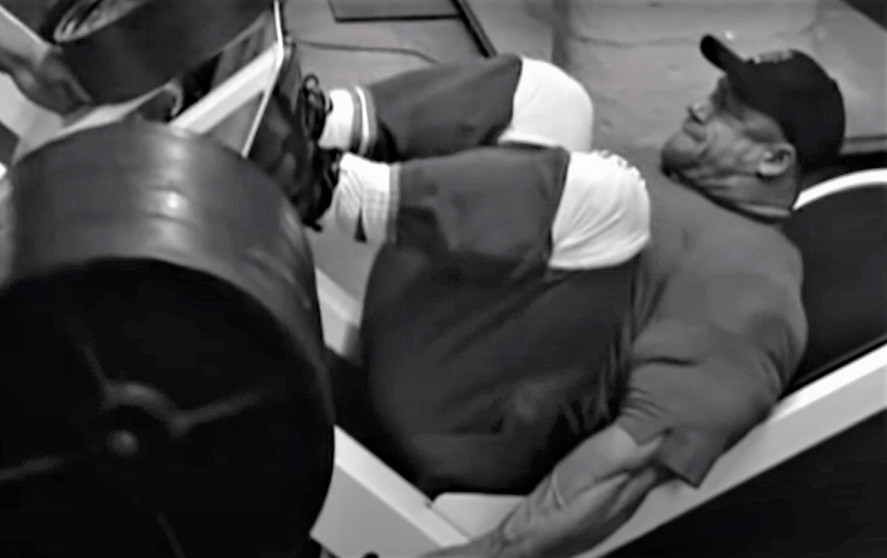
Your final moderate-intensity warmup set should also be pushed to near-failure but with a lighter weight and higher reps (12-15) than your working set.
Do one all-out, beyond-failure set per exercise. This is the working set. Yates said: “If you feel you can attempt a second set, then you couldn’t have been pulling out all the stops during the first set.”
Do 3-4 working sets for smaller body parts, like biceps, and 6-8 working sets for larger body parts, like back.
When doing working sets, aim for complete failure at 6-8 reps and extend beyond failure with 2-3 forced reps, rest-pause reps, or drop set reps. Yates said: “Control the weight and go to failure, and sometimes beyond. This’ll really help to force muscle growth and completely tax the muscle. Use the weight as a tool to put maximum stress on the working muscle.”
High-intensity does not mean only free weights. Dorian Yates used machines frequently, feeling their different cams, pulleys, and vertical resistance provided excellent muscle stimulation.

Yates said: “Focus. Use your time in the gym wisely. Remember, you’re there for a reason—to reach your goals and make progress. So stay focused on the task at hand and save the chat for after the gym.”
If you don’t have a training partner, utilize more machines and cables. These will allow you to more safely reach failure and then, with a quick reduction in weight, continue beyond full-rep failure.
Yates said: “Remember, it’s a marathon not a sprint so I’d advise you to increase the weight only when you can comfortably reach 10-12 reps.”
Yates said: “Train with intensity! Give it your all at the gym, each and every session.”
DAY 1: SHOULDERS, TRICEPS, ABS
FRONT & SIDE DELTOIDS
Smith Machine Military Press — 2 warmups x 12-15 reps, 1 set x 8-10 reps
Seated Dumbbell Side Lateral — 1 warmup x 12 reps, 1 set x 8-10 reps
One-arm Cable Lateral — 1 warmup x 20 reps, 1 set x 8-10 reps
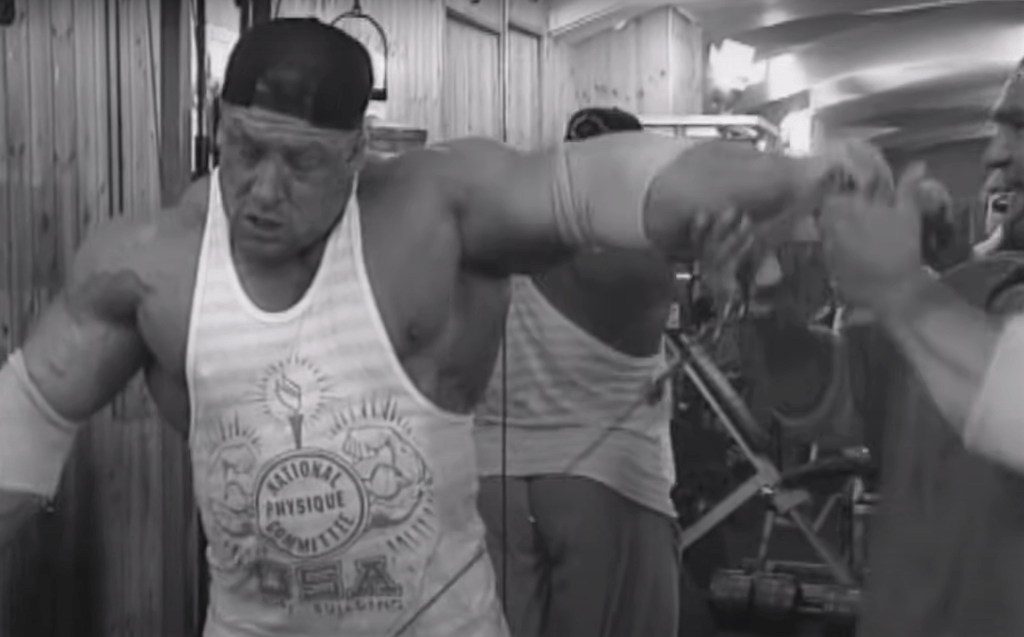
Yates wanted to make certain he hit his front and side deltoids with minimal assistance from secondary muscles. This is why he preferred to do his military presses seated in a Smith machine and his dumbbell side laterals also seated. He did two exercises for side delts and only one for front delts, because front delts also get worked with chest presses. One-arm cable laterals provide resistance from start to finish (due to the vertical weight stack), while the resistance will be greatest on the top halves of dumbbell side laterals.
TRAPEZIUS
Dumbbell Shrug — 1 warmup x 12 reps, 1 set x 10-12 reps
Yates said: “If you had asked about traps training earlier in my bodybuilding career, I probably would have suggested either barbell or machine rows and called it a day. However, in 1995, I suffered a relatively minor forearm injury that limited the amount of weight I could lift with my hands in a prone position. Mind you, I was performing my shrugs with up to 650 pounds at the time, so I had to find a way to work around my injury to continue my traps training. Before the injury, I had never considered doing dumbbell shrugs to work my traps. The equivalent of 650 pounds in dumbbells would be two 325-pounders, and dumbbells that heavy simply don’t exist. I had no other option except to use dumbbells totaling a much lighter weight. At first, I thought I’d lose size in my traps as a result of the lighter weight, but the opposite wound up being the case. The dumbbells allowed a range of motion I couldn’t experience with a barbell. The result was growth and unprecedented traps stimulation from bottom to top.”
TRICEPS
Pushdown — 2 warmups x 12-15 reps, 1 set x 8-10 reps
Lying EZ-bar Triceps Extension — 1 warmup x 12 reps, 1 set x 8-10 reps
One-arm Reverse Grip Pushdown or Nautilus One-arm Extension — 1 x set 8-10 reps

Yates said: “I prefer using an EZ-curl bar for skullcrushers [lying triceps extensions], as it takes stress off the wrists and elbows. Make sure to follow proper form when performing these, which means lowering the bar to your forehead and keeping your elbows immobile throughout the movement. I’ve seen many people turn this into a close-grip bench press by using sloppy form. Avoid doing that. Also, always have a spotter handy for this exercise.”
ABDOMINALS
Crunch — 3 set x 20-25 reps
Reverse crunch — 3 set x 12-15 reps
The one body part that Dorian Yates trained in a conventional manner was abs. He did six working sets and hit higher reps (12-25).
DAY 2: BACK
UPPER BACK
Hammer Strength Pulldown or Nautilus Machine Pullover — 2 warmup x 12-15 reps, 1 set x 8-10 reps
Underhand Barbell Row — 1 warmup x 12 reps, 1 set x 8-10 reps
Hammer Strength Machine One-arm Row — 1 set x 8-10 reps
Cable Row — 1 set x 8-10 reps

Dorian Yates gave his back (including rear delts) its own workout, and he had arguably the greatest back ever seen on an bodybuilding stage. He was a big fan of the Nautilus pullover machine, and had one in his Temple Gym. (Nautilus was launched by Arthur Jones, creator of high-intensity training.) This allowed him to work his lats without involving his biceps, and pre-exhaust his back before moving on to rows, which did involve his biceps. Likewise he liked Hammer Strength (that company was launched by Arthur Jones’ son), and did his pulldowns and one-arm rows on those plate-loaded machines, which he helped popularize. Until he tore his biceps in 1994, Yates preferred to do his barbell rows underhand. Underhand or overhand, barbell rows were always the core of his back routine.
REAR DELTOIDS
Hammer Strength Machine Rear Delt Fly — 1 set x 8-10 reps
Bent-over Dumbbell Rear Lateral — 1 set x 8-10 reps
As with side delts, Dorian Yates did two exercises for rear delts.
LOWER BACK
Weighted Back Extension — 1 set x 8 reps
Deadlift — 1 set x 8 reps

Again, Yates pre-exhausted, doing the isolation exercise, back extensions (a.k.a. hyperextensions), before deadlifts in order to focus the latter compound exercise more on his lower back. He called the latter exercise “continuous tension deadlifts” because he never wanted it to become a power exercise. Instead, he wanted to feel his back working from start to finish of every rep.
DAY 3: CHEST, BICEPS
CHEST
Barbell Incline Press — 3 warmups x 12-8 reps, 1 set x 8 reps
Hammer Strength Chest Press — 1 warmup x 10 reps, 1 set x 6-8 reps
Dumbbell Incline Flye — 1 warmup x 10 reps, 1 set x 8 reps
Cable Crossover — 1 set x 10-12 reps

Again, Yates used a Hammer Strength machine. But before then, he pyramided up to one set of barbell incline presses. He said this about that basic exercise: “I feel that pressing on an incline as well as on a decline allows a better range of movement than flat bench presses. The angle of the bench should be low, about 30 degrees. Some people don’t have the range of motion in their shoulders to come all of the way down to the upper chest when performing these, whether it’s due to a structural limitation or an injury. If this is your case, don’t force the issue. Come down as far as you can without doing damage to your shoulder joints. Keep the bar under control at all times, making sure to forcefully squeeze your pecs at the top of the movement.”
BICEPS
Incline Dumbbell Curl — 1 warmup x 10 reps, 1 set x 6-8 reps
EZ-bar Curl — 1 warmup x 10 reps, 1 set x 6-8 reps
Nautilus Machine One-arm Curl — 1 set x 6-8 reps

Dorian Yates trained his biceps with only one weekly workout of only three working sets. It lasted a mere 10 minutes. He said: “Unlike bodyparts like thighs and back, where I would go to failure and then perform forced reps, partials, and negatives to push well past positive failure, I generally never trained my biceps past the point of failure. Sometimes, I might go to failure, put the weight down for 10 seconds and then perform another two reps in rest-pause fashion. What I would never do, though, is hammer my biceps past the orthodox failure point as I would with a larger bodypart, like back. Overdoing forced and negative reps delivers too much stress on the fragile joint and muscle-fiber structure of the biceps. This can ultimately have a negative effect on the central nervous system, leading to stagnant gains in muscle.”
DAY 4: LEGS
QUADRICEPS
Leg Extension — 2 warmups x 12-15 reps, 1 set x 10-12 reps
Leg Press — 2 warmups x 12 reps, 1 set x 10-12 reps
Hack Squat — 1 warmup x 12 reps, 1 set x 10-12 reps

He did a little higher reps for quads (10-12) than for most body parts (6-10). Yates squatted for his first few years of training, until he determined he could grow his quads better and relieve his persistent knee pain with machine exercises. Again, he does a pre-exhaust to kick off leg day: isolation exercise (leg extension) before two compound exercises (leg press and hack squat). The six-time Mr. Olympia believes too many weight-trainers go through the motion on leg extensions. Get full reps from maximum stretch to maximum contraction and go to failure or beyond. Similarly, make certain to get full reps on the leg presses and hack squats. He typically used a narrow stance on both the leg presses and especially the hack squats, to focus more on his other quads. The most important thing is maximally stressing the quads with each of the three working sets.
HAMSTRINGS
Lying Leg Curl — 1 warmup x 10-12 reps, 1 set x 10-12 reps
Stiff-leg Deadlift — 1 set x 8-10 reps
Another pre-exhaust: isolation (lying leg curl) before compound (stiff-leg deadlift).
CALVES
Standing Calf Raise — 1 warmup x 10-12 reps, 1 set x 10-12 reps
Seated Calf Raise — 1 set x 10-12 reps
Dorian Yates had two of the best calves in Mr. Olympia history. Partly, this was genetics. But he also trained calves with the same low-volume, high-intensity assault he applied to other body parts. Yates said: “I never cease to be amazed at the number of bodybuilders I’ve encountered who seem to think that the muscle tissue in calves differs in biological composition from that of other muscles. Skeletal muscle is skeletal muscle, no matter where it is in the body, and in order for it to grow it needs to be trained in the same manner. For bodybuilders, that means heavy and intense. The high-rep theory for calves—i.e., performing 25-30 reps per set—has been around for years, but it never made sense to me, nor does it bear the logic of bodybuilding. To force a muscle to grow, it must be taken to total fatigue through heavy, low reps.”
DORIAN YATES WORKOUT: FREQUENTLY ASKED QUESTIONS
How many hours a day did Dorian Yates workout?
One. Yates during his Olympia-winning years trained for approximately 60 minutes from start to finish.
What is the Dorian Yates 4-day split workout?
Day 1: shoulders, triceps abs.
Day 2: back
Day 3: chest, biceps
Day 4: legs
How much could Dorian Yates lift?
We have an entire article devoted to this question. Some of the highlights are 435-pound underhand rows for 6-8 reps, 425-pound incline presses for 4 reps, and 1265-pound leg presses for 10-12 reps.
Did Dorian Yates do flat bench presses?
Early in his amateur career he did. He recorded in his logbook a bench press of 310 pounds for five reps. But he quit flat benches early, and did not do them during his professional career when he was much stronger. As noted above, he did do incline barbell presses throughout his career.
Why didn’t Dorian Yates squat?
He squatted for his first few years of training. Chronicled in a journal entry on March 1, 1985, when he weighed 230, young Yates squatted 405 pounds for seven reps followed by 425 for four. But he eventually determined he could grow his quads better and relieve his persistent knee pain by avoiding squats and focusing on hack squats and leg presses instead. Yates is not anti-squat for everyone, but he determined they weren’t for him.
How heavy did Yates train?
As heavy as he could, typically in the 6-10 rep range (10-12 for legs), going to failure and then beyond failure with 2-3 forced reps, rest-pause reps, or drop set reps. He was always striving to get stronger.
Related Content:
Dorian Yates Ranked #5 on Best Bodybuilders of All Time, According to A.I.

